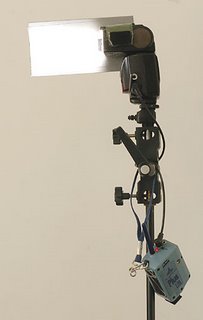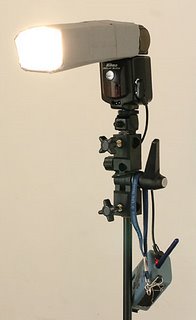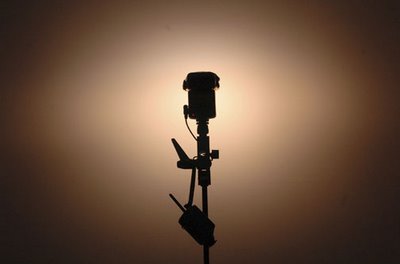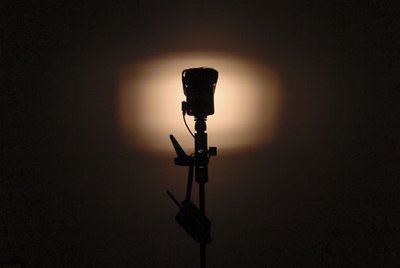Sometimes what makes a photo sing is not so much where the light is, but where it isn't. And, given that you already have a basic, off-camera strobe setup, you can make the gear you will need to restrict light for just a few pennies.
Remember when we put the Velcro on the sides of your flash head? It holds gels fine, but you should also add another piece of (loop side) Velcro so you can fasten a GoBo to your light.
("GoBo" is slang for something that goes between your light and something you do not want it to hit.)
 To make a useful-sized GoBo, Cut a piece of still cardboard to make a rectangle about 4x8 inches. Cover it with gaffer's tape and stick some Velcro (the "hooks" side) at one end and at about a third of the way from the other end. This will allow you to attach it to the side of your flash either way so that you can choose how far it sticks out.
To make a useful-sized GoBo, Cut a piece of still cardboard to make a rectangle about 4x8 inches. Cover it with gaffer's tape and stick some Velcro (the "hooks" side) at one end and at about a third of the way from the other end. This will allow you to attach it to the side of your flash either way so that you can choose how far it sticks out.While I am thinking about it, you'll want to get a small roll of gaffer's tape. Looks like duct tape, but it is not. This stuff is light-tight, leaves no residue (unless you leave it on for about 6 months) and is indispensable to have in your trunk/light bag.
Back to the GoBo.
Now, you have a sort of "barn door" that can block the light from your flash in the direction that you choose.
Say you are using your flash to side/backlight something. Your flash, being small and not-too-powerful, is just out of the camera frame. The GoBo could be stuck on the side of the strobe closest to you to keep light from flaring into your lens.
You can also use one on each side of the flash to make light that spreads vertically, but not horizontally (or vice versa.) You can keep light off of a background this way, as you may be lighting it from another source.
If you are going to make one of these, you may as well blow a whole quarters worth of Velcro and make four or six of them. They just slide into the lid or back pocket of a Domke bag and weigh almost nothing. No brainer.
 If you want to restrict the light even more, you'll want a snoot. It is nothing more than a sort of tunnel for the light to go through that will restrict it is all directions except for the exact direction the strobe is pointed.
If you want to restrict the light even more, you'll want a snoot. It is nothing more than a sort of tunnel for the light to go through that will restrict it is all directions except for the exact direction the strobe is pointed. Just shape the cardboard into a rectangular-shaped tube that will slide over your flash head. Make a few - 6", 8", 12" - the longer the tube, the tighter the beam of light. Now cover it in gaffer's tape to make it more durable and light-tight.
(By the way, when you shoot with a snoot, set your flash on its most telephoto setting. No sense in wasting power by sending a wide beam of light just to block it with a snoot.)
How do you know how big your spot will be? Pop it against a wall from a good working distance (say, 5 feet) to get an idea of the beam spread of the various tubes. You might want to write your results on the tubes themselves, as in "1x2-foot pattern at 5 feet," etc.
 This is a flash fired against the wall (4 feet away) at the "85mm" zoom setting. Note the pattern of the light.
This is a flash fired against the wall (4 feet away) at the "85mm" zoom setting. Note the pattern of the light. This is the same setup, with an 8" cardboard snoot on the flash.
This is the same setup, with an 8" cardboard snoot on the flash.Now, how are you gonna work like this without modeling lights? I'll tell you.
You don't need no stinkin' modeling lights.
Here's your modeling light:
You ask your subject, "Can you see the front of my flash through the tube from where you are sitting?" If they can, the light will be falling on their face.
You know that cool shaft of light you like to exploit when you see it coming from a window or something? Now you can make it any time.
This is a very useful style of light for cool portraits, but you have to be aware of your ambient level. Crank up the shutter speed for more drama, or open it up for more detail in the unlit areas.
For many beginners, this is a new technique that will open up loads of possibilities. Spend an evening experimenting with it at home to start to understand what it can do.
Next: Textural Lighting for Detail Shots
No comments:
Post a Comment